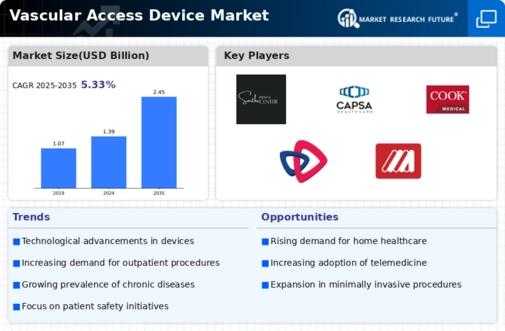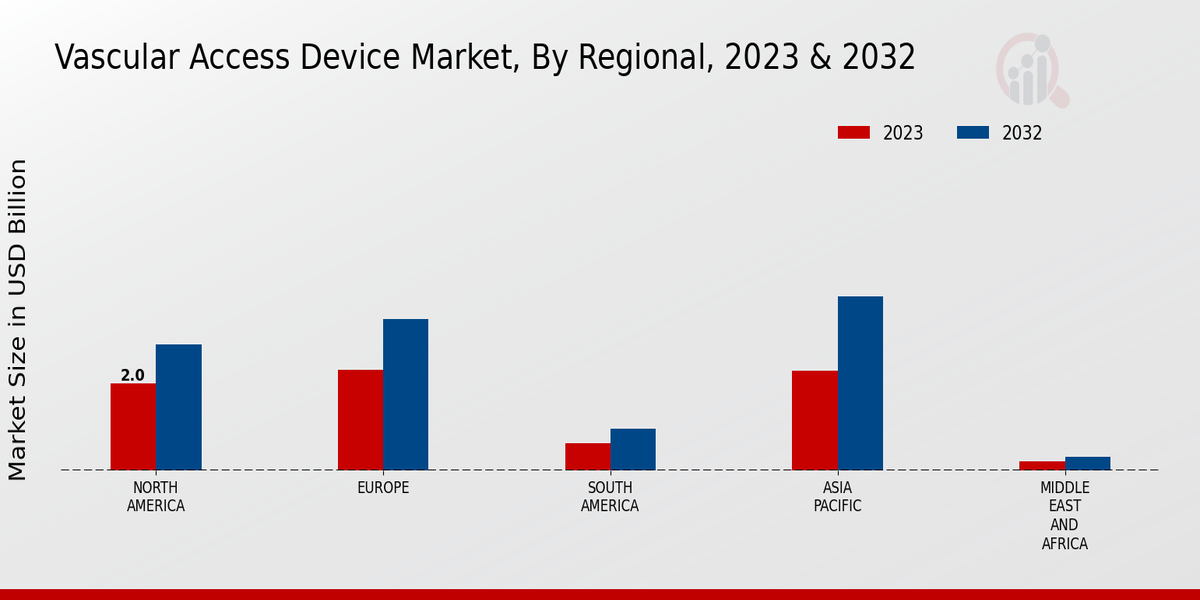Market Growth Projections
The Global Vascular Access Device Market Industry is projected to experience substantial growth over the next decade. With a market valuation of 1.39 USD Billion in 2024, it is anticipated to reach 2.45 USD Billion by 2035, reflecting a compound annual growth rate of 5.3% from 2025 to 2035. This growth is driven by various factors, including the rising prevalence of chronic diseases, technological advancements, and an increasing geriatric population. The market dynamics suggest a robust expansion trajectory, indicating that stakeholders should prepare for significant developments in the vascular access device sector.
Increasing Geriatric Population
The aging population globally is a significant driver of the Global Vascular Access Device Market Industry. Older adults are more susceptible to chronic illnesses that require vascular access for treatment. According to demographic studies, the proportion of individuals aged 65 and older is steadily increasing, leading to a higher demand for medical interventions that utilize vascular access devices. This demographic shift is expected to contribute to the market's growth trajectory, with an estimated market value of 1.39 USD Billion in 2024. The need for effective and reliable vascular access solutions for this population segment is likely to sustain market expansion in the coming years.
Rising Prevalence of Chronic Diseases
The Global Vascular Access Device Market Industry is experiencing growth driven by the increasing prevalence of chronic diseases such as diabetes and cancer. These conditions often necessitate long-term vascular access for treatments like chemotherapy and dialysis. For instance, the World Health Organization indicates that the number of individuals with diabetes is projected to rise significantly, leading to a higher demand for vascular access devices. This trend is expected to contribute to the market's valuation of 1.39 USD Billion in 2024, with projections suggesting it could reach 2.45 USD Billion by 2035, reflecting a compound annual growth rate of 5.3% from 2025 to 2035.
Regulatory Support and Standardization
Regulatory bodies are increasingly focusing on the standardization and safety of vascular access devices, which is positively impacting the Global Vascular Access Device Market Industry. Initiatives aimed at improving device safety and efficacy are being implemented, ensuring that manufacturers adhere to stringent guidelines. This regulatory support fosters innovation and encourages the development of advanced vascular access technologies. As a result, the market is likely to benefit from enhanced consumer confidence and increased adoption of these devices. The ongoing efforts to standardize practices and improve patient safety are expected to contribute to the overall growth of the market in the coming years.
Technological Advancements in Device Design
Innovations in the design and functionality of vascular access devices are propelling the Global Vascular Access Device Market Industry forward. Enhanced materials and technologies, such as biocompatible coatings and smart devices that monitor patient conditions, are being developed. These advancements not only improve patient outcomes but also reduce complications associated with traditional devices. For example, the introduction of ultrasound-guided vascular access techniques has significantly increased the success rates of catheter placements. As these technologies become more prevalent, they are likely to drive market growth, contributing to the anticipated increase in market value over the next decade.
Growing Demand for Home Healthcare Solutions
The shift towards home healthcare is influencing the Global Vascular Access Device Market Industry positively. Patients increasingly prefer receiving treatments at home, which necessitates the use of vascular access devices that are safe and easy to manage. This trend is particularly evident in the management of chronic diseases, where patients require regular infusions or dialysis. The convenience and comfort of home healthcare are likely to drive the demand for vascular access devices, as they facilitate outpatient care. As the market evolves, this segment is expected to play a crucial role in achieving the projected market growth, with a valuation of 2.45 USD Billion by 2035.







